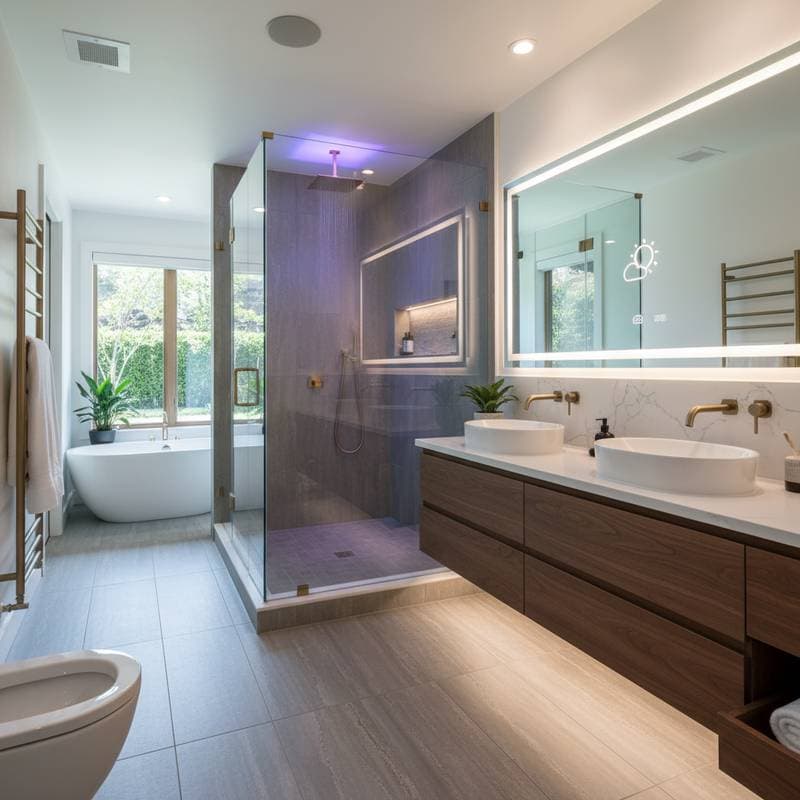Bathroom Remodel Costs in 2025: Which Ones Pay Off
A bathroom remodel transforms daily routines and enhances property value when planned thoughtfully. Homeowners frequently inquire about remodels that deliver the strongest return on investment. The response varies by bathroom size, design preferences, and finish quality. Focus on upgrades that align with practical use and appeal to potential buyers.
This guide details expected expenses, projects with solid returns, and strategies to design a remodel that provides both immediate comfort and future financial benefits.
ROI by Project Type
Various upgrades produce differing returns. Awareness of high-value options directs investment decisions effectively.
High-Return Upgrades
-
Walk-in Showers: Convert a tub to a walk-in shower for improved accessibility and contemporary style. Incorporate frameless glass doors and non-slip tiles to enhance safety and usability. These changes appeal to aging-in-place buyers and modernize the space without excessive cost.
-
Double Vanities: Install dual sinks in primary bathrooms to accommodate shared routines for couples or families. This addition improves daily efficiency and demonstrates considerate layout planning.
-
Energy-Efficient Fixtures: Select low-flow toilets, energy-saving LED lights, and water-conserving faucets. These features reduce utility bills and draw environmentally aware purchasers who prioritize sustainability.
-
Updated Tile and Grout: Refresh flooring and walls with new tiles to achieve an immediate clean appearance. Choose porcelain or ceramic varieties for their resistance to humidity and long-term durability.
-
Neutral Color Schemes: Opt for whites, light grays, or earth tones to broaden buyer appeal. Such palettes create a versatile backdrop that facilitates easier resale.
Moderate-Return Upgrades
-
Heated Floors: Provide warmth in cooler regions, though installation expenses remain high. Returns hinge on local demand for premium comfort features.
-
Freestanding Tubs: Deliver striking visual impact, but practical use varies. These elements contribute more to aesthetic value than everyday functionality.
-
Custom Vanities: Supply ample storage and personalized style, yet stock models often match performance at reduced prices.
Low-Return Upgrades
-
Overly Personalized Themes: Bold tile patterns or sculptural sinks may deter prospective buyers seeking neutral spaces.
-
High-End Tech Additions: Features like interactive mirrors or integrated audio systems intrigue initially but seldom justify costs through increased appraisals.
-
Expensive Stone Slabs: Luxurious materials impress visually, yet they boost value only in homes with matching high-end elements throughout.
Factors That Influence Cost
Multiple elements determine total expenses and potential returns. Grasp these aspects early to align the project with specific objectives.
Size and Layout
Expansive bathrooms demand greater investments in materials, fixtures, and workmanship. Designs requiring plumbing relocations escalate labor demands and overall budgets.
Material Choices
Durable quartz countertops and porcelain tiles offer reliability and strong value retention. Natural stones provide upscale elegance at higher prices. Engineered alternatives strike a practical balance between affordability and appearance.
Labor and Permits
Professional labor constitutes the bulk of expenses. Engage certified contractors to guarantee structural integrity and adherence to building codes. Permits incur minor charges but safeguard resale by verifying compliant modifications.
Geographic Location
Local wage standards and supply chains impact pricing. Properties in premium markets face elevated costs but often recover more upon sale due to heightened demand.
Timing Your Remodel for Best Return
Strategic scheduling affects return potential. Complete updates shortly before selling to maximize appeal, though this shortens personal enjoyment. Earlier renovations allow prolonged use while preserving long-term value.
Refresh bathrooms every 10 to 15 years, particularly when fixtures age or trends evolve. Incremental changes, such as updated hardware or paint, maintain freshness without full overhauls.
Common Questions About Bathroom Remodel ROI
How Much Value Does a Bathroom Remodel Add?
A strategically executed remodel recoups 50 to 75 percent of costs at sale. Results vary by economic climate, regional trends, and selection of materials. Mid-level projects typically yield optimal recovery rates.
Should You Replace the Tub with a Shower?
Consider conversion if a secondary tub exists elsewhere. Showers simplify cleaning and attract diverse buyers. Retain at least one tub for households with young children.
Do Energy-Efficient Fixtures Really Matter?
These selections lower ongoing expenses and resonate with sustainability-focused buyers. Savings often offset initial outlays within several years.
Is DIY Worth the Savings?
Amateur efforts reduce costs for simple tasks like painting or accessory swaps. Delegate complex elements such as plumbing, tiling, or wiring to experts. Poor execution risks future fixes that diminish returns.
What If the Bathroom Is Very Small?
Emphasize space optimization with floating vanities, pale hues, and expansive mirrors to create an illusion of openness. Compact areas incur lower remodeling fees and still generate impressive value gains.
Expert and User Insights
Remodeling specialists emphasize that simplicity drives sales. Neutral palettes, uniform materials, and precise craftsmanship outweigh designer labels in buyer evaluations. Forum participants echo this, noting that prospective owners prioritize orderly designs and reliable operations.
Real estate professionals observe that renovated bathrooms trail only kitchens in swaying purchase decisions. Contemporary bathrooms enhance listing photos and convey readiness for occupancy.
Plan Your Remodel for Lasting Benefits
Approach bathroom updates with a focus on functionality and broad appeal to secure both enjoyment and equity growth. Evaluate needs against budget constraints, consult local experts for tailored advice, and document all improvements for future disclosures. These steps ensure the project enhances life quality while positioning the home competitively in the market.





